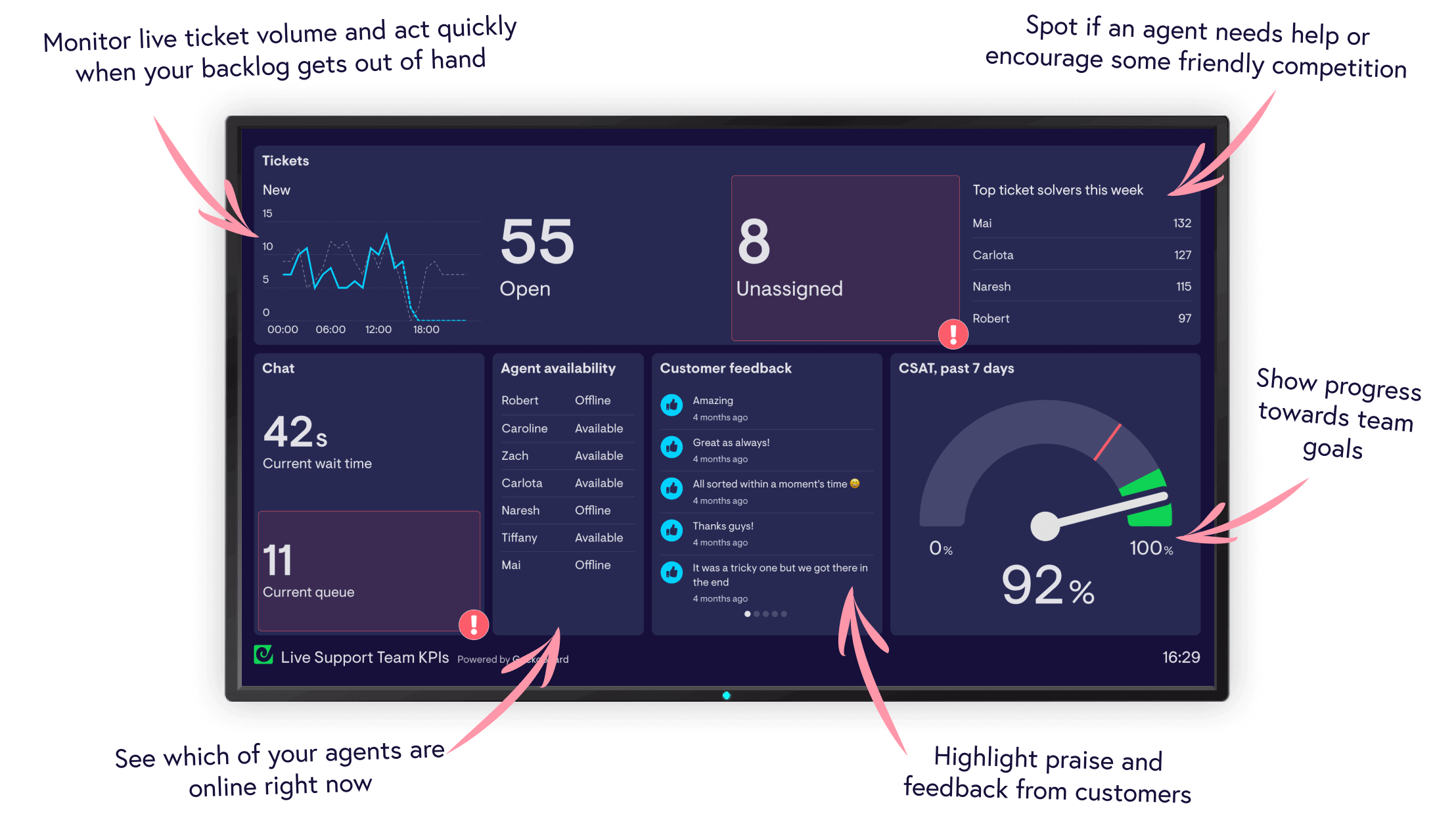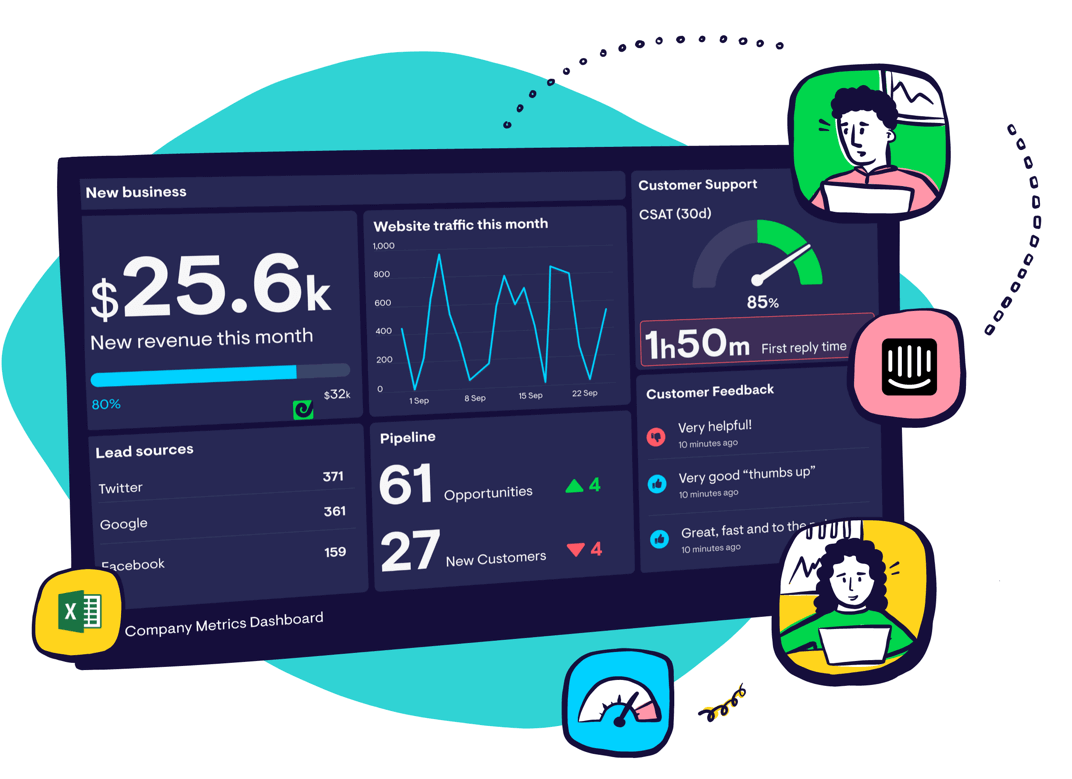Customer Satisfaction (CSAT)
What is Customer Satisfaction Score (CSAT)?
CSAT measures your customers’ satisfaction with the service they receive. Customers are sent a short survey after an interaction with someone in the Support team asking them to rate the help they received. The method of scoring can vary (with the most common being ranking service on a scale of 1-5 or Good/Bad). A team’s CSAT score is then calculated as the percentage of positive survey scores.
.png)
How do you calculate CSAT?
CSAT is simply the percentage of all the CSAT survey responses you receive that are positive.
CSAT (%) = (No. positive responses / Total no. responses) * 100
For example, if you had 300 positive responses out of 400 total responses your CSAT score would be 75%.
300 / 400 x 100 = 75%
The definition of positive responses depends on the scale being used. In the example of scoring 1 - 5 (1 being bad and 5 being great) any scores above 4 would be included as positive responses.
CSAT can be calculated for different time periods e.g. today, this week, last 30 days, this year and often it’s useful to look at a combination.
Monitoring CSAT for the current day can alert you to dissatisfied customers quickly enough that you may be able to still turn things around by following up with the customer or agent.
However, to track trends in overall team performance, and whether initiatives to improve customer satisfaction are paying off you will need to track CSAT by week or month for a longer period of time.
Why measure CSAT?
Ultimately, the goal of most Customer Support teams is to provide excellent customer service. CSAT is the best single KPI for measuring the quality of the service provided and tracking how your team is performing against this goal. All other important Customer Support metrics (like First Response Time (FRT) and Average Resolution Time (ART)) ultimately feed into a team’s CSAT score.
CSAT surveys are easy to implement, often being included in your ticketing solution.
In addition to being a great metric to track the performance of your support team over time, many teams choose to follow up on each negative CSAT survey response as it comes in to find out what went wrong and to get an insight as to where the product or service is not meeting the customer’s expectations.
CSAT versus NPS: which is better?
Though both track customer sentiment, each does so in a different way. CSAT scores are based on a customer’s recent support interaction whereas Net Promoter Score (NPS) looks at how likely the customer is to recommend the brand/service to others.
CSAT surveys usually take place shortly after an interaction whereas NPS surveys are normally collected periodically (e.g. every six months).
The advantage of using CSAT over NPS for Customer Support teams is that it better measures their contribution.
While NPS may be a better measure of how satisfied customers are with your overall product/service it is influenced by many things outside of the Customer Support team’s direct influence. Pricing, product performance, customer service and brand all contribute and it can be difficult to isolate the relative importance of each.
Our view is that all Support teams should track CSAT, but NPS is also useful for identifying ways to better serve your customers’ needs.
Here are some useful resources if you’re working with NPS:
Limitations of CSAT
CSAT is dependent on your customers taking time to respond to the survey. Naturally, not all customers do, so you’ll never get a full picture of how all your customers feel. Those responding are often on either end of the scale and are either very happy or very unhappy. Meaning you’re not always tracking those who lie content or somewhere in the middle. It’s good practice to try and get as many customers to respond as possible and to track your response rate.
Satisfaction surveys can sometimes be misinterpreted by customers and the score they give is not necessarily an accurate representation of how they feel. Here are a couple examples; the customer might use the survey as a place to score the brand as a whole rather than one interaction or they could be frustrated by how hard it was to reach someone even though the service they received was great. With the latter, it’s worth considering Customer Effort Score (CES) a key health metric for understanding how easy it is for your customers to get help.
It’s also worth noting that not all tools track CSAT in the same way, some may artificially inflate your score. Read our post on the hidden intricacies of CSAT.
What is considered a good CSAT score?
As CSAT is such a common metric for CS teams to track, plenty of benchmarks reports exist.
However, while industry benchmarks provide useful general pointers, it’s important to remember every business is unique, with different systems, products, and customers. Also, benchmark reports rarely share differences in methodology for how teams measure CSAT or overall response rates - another reason comparisons should be taken with a pinch of salt.
Customer satisfaction industry benchmark resources
To get the most from industry benchmarking and to compare your team’s CSAT score to see how you’re faring, try and find reports that show data for companies of a similar size, structure and industry to your own.
Here are a few places you can view industry benchmarks for CSAT:
Internal benchmarks
Comparing your CSAT score to historic team performance or to other teams within the company (perhaps Support teams for other regions or brands) is another useful approach.
For more help benchmarking, see this post: How to figure out if your CSAT benchmark is realistic (checklist included)
How to create a good customer satisfaction survey
To get the most representative CSAT score possible you want survey response rates to be high. To achieve this you should make your survey as quick and easy as possible to complete. Here are some resources on nailing your satisfaction surveys:
-
How to Design Customer Satisfaction Surveys That Get Results [+Templates]
-
9 Simple Ways to Boost Customer Satisfaction Survey Response Rates
How to find out your CSAT in your ticketing tool
Most modern ticketing systems have the ability to measure CSAT built-in. Here are a few ways to find and track your CSAT score in popular Support platforms:
-
Zendesk: Viewing your CSAT (customer satisfaction) score and ratings
-
Intercom: Measure customer satisfaction with conversation ratings
There are also standalone tools like Delighted for sending CSAT surveys and recording your results.
If CSAT and your other important metrics are spread across multiple tools and you’d like to be able to bring them all into one place, try sharing your data on an easy to read dashboard with Geckoboard.
How to improve your CSAT score
If you’re looking to improve your CSAT score, how do you go about it?
Here are a few of the suggestions we’ve heard from our customers, partners and the Support team here at Geckoboard.
Training
Often, when your CSAT score is below your expectation it is a knowledge issue. Looking in more detail at negative scores for trends and identifying areas where the team may need further training is a good place to start.
Communicate your goals
If your team isn’t aware or regularly reminded of the overall goal they’re working towards, how can they know what impact their performance has? Sharing your CSAT score alongside other metrics helps agents become familiar with what impacts this score and how their actions can shift it.
Setting up a real-time dashboard for your team ensures all your agents can see what’s going at a team level right now.

Automation and processes
Are there ways you could reduce the time agents spend on certain tasks? Automating simple tasks and building processes to remove friction can give busy Support teams breathing space to focus on more complicated queries and higher value customers where they can add more value. Make sure your team is triaging effectively so that tickets are assigned based on agents’ skill sets. You might set up a chatbot to field your most common queries, or you could prepare a number of template responses to save agents time when a simple request comes through.
Here are some tips and resources that may be useful when looking to become more efficient within Support:
-
Create triggers for when a conversation has too many updates
-
Give tickets a priority score to help agents prioritize their workload
-
Review your tagging process and build a taxonomy to ensure accuracy
For more suggestions on ways to boost efficiency, take a look at our comprehensive resource for Customer Service, UNSTUCK.
Improve First Response Time (FRT)
FRT and CSAT are closely linked. Customers want to receive a response quickly, if you leave them waiting around they’re less likely to give a great satisfaction score even if you solve the issue as soon as you speak with them.
By improving your FRT, you’ll most likely see an improvement to your overall CSAT score too. Reconsider scheduling or shift patterns to cover the lines during your busiest time, make sure all agents are well-trained and confident and finally, consider new channels for Support that allow a faster response.
Quality conversations
Maintaining a high level of service means spending time looking at the quality of the conversations your team is having. Here are some suggestions on how make sure they’re top tier:
-
Review all negative scores - why not jump on a call with the customer to find out what went wrong?
-
Discuss great and not so great conversations regularly in team meetings
-
Use tools such as Klaus to allow individual team members to review and rate each other’s conversations making sure that the same level of service is delivered for every customer.
-
If you have an agent incentive scheme, include quality scores to promote excellent service.
Monitor supporting metrics
It’s useful to track other KPIs in addition to CSAT to get a broader picture of how your team is performing and identify opportunities for improvement.
KPIs such as Ticket Volume and First Response Time (FRT) give an indication of the workload faced by a support team and can explain variations in CSAT.
Take a look at these KPIs for more detail on calculating, pros, and cons of each:
Meet your customer’s expectations
Your customers are likely to have certain expectations of the service your company provides. In order to keep customers happy and avoid frustration, give them information they need to be aware of what they can expect so they’re not in the dark. Let them know they’re 3rd in the queue or tell them an average wait time for a response.
The Effortless Experience (a popular book for Support teams) argues that you don’t need to blow your customers away, you just need to make the experience of dealing with their issue as hassle free as possible.
Become UNSTUCK
For more tips and ideas to improve the way your team works, we’ve compiled a huge list of recommendations from contributors across the world of Support in UNSTUCK: The Inspiration Playbook for Customer Service Teams.
Using Geckoboard dashboards to impact your CSAT score
CSAT is one of the most popular metrics among Geckoboard customers in Support teams. We’ve interviewed tons of customers over the years but here are a few of our favourite case studies where teams have used dashboards to positively impact their CSAT score:
Sign up with Geckoboard for free to display your CSAT score and all your most important Support metrics on a real-time dashboard.

